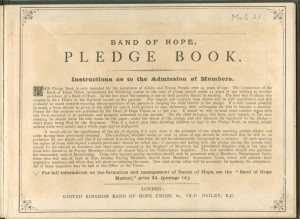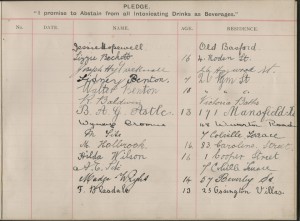
January 30, 2015, by Kathryn Steenson
A Toast to Temperance
Are you one of the thousands of people participating in the January ‘Dryathlon’ and giving up alcohol for the month to raise money for charity? If so, then congratulations – the end is in sight!
Focussed, month-long charity campaigns such as Stoptober and Dry January seem to have risen to prominence over the last few years. They work because they take advantage of two key points: most people can change their behaviour for the short period of a month; and by publicly committing to do something, there is an element of social support and expectation.
This second point has been understood for a long time. Temperance movements adopted the same approach, with members declaring their intention to abstain from all intoxicating beverages in front of their friends, family and neighbours. Many non-conformist churches were involved with the temperance movement. This is a page from the Band of Hope Pledge Book, in the records of the Mansfield Road Baptist Church, dated from the early 20th century (Ref: Mr S 21). Band of Hope was a nationwide Christian movement that had been founded in London in 1855. It produced tracts and organised lectures and rallies about the evils of alcohol and cautionary tales from those whose health and happiness had been blighted by excessive drinking.
Pledge Books were where members swore to abstain from alcohol. Signing was a solemn affair, preferably to be carried out in silence and in front of the whole group. New members had a probationary period of one month. At the next meeting their names were read out and if they had remained teetotal and were willing to continue abstaining from drinking, then they were formally admitted as Members and invited to pay a subscription. The money was put back into running the temperance organisation’s activities.
It was not just adults who signed, as this Church pledge book has been signed by children. It’s undated but is probably from about 1909, as the two boys Sidney and Walter Benton, listed as aged 7 and 10, are probably the same brothers listed on the 1911 Nottingham census aged 9 and 12. They signed despite the fact that the instructions clearly state that it was not to be signed by anyone under 14 – not because it seems strange to have seven year olds commit to being lifelong teetotallers, but because “young people seldom write very neatly, and a whole page may be disfigured”!
The period from the late 19th to the early 20th century was the height of the temperance movement’s success. The calls for total abstinence and legal restrictions had started in about the 1830s, which was a shift from earlier emphasis on moderation and avoiding hard liquor. From the 1930s, temperance movements declined and eventually the organisations disbanded or shifted focus to more general alcohol and drug awareness.
There are several pamphlets, pledge books, cartoons, newspaper clippings and letters about temperance scattered through both manuscripts and the special collections, all of which can be viewed in our Reading Room at King’s Meadow Campus. For more information about Manuscripts & Special Collections, visit our website or follow us @mssUniNott.
Thumbnail photograph copyright babypopnet at https://www.flickr.com/photos/babypopnet/3341320762/
No comments yet, fill out a comment to be the first



Leave a Reply